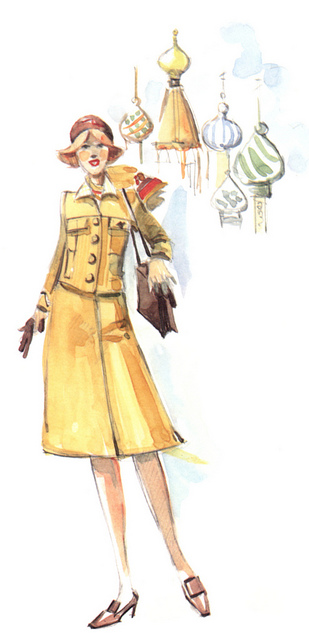Fifth in a series (for the rest, see below).
When it came time to refresh the flight crew wardrobe in 1977, Elio Berhanyer was given the job once again. And as a result, for the next half-dozen years the colour palette took a drastic turn for the earth-toney – specifically toasted beige, which Berhanyer felt to be another colour that was traditional as well as stylish, timeless, and versatile in various parts of the world at all times of year.
This change, however, affected just the cabin crew. Ground personnel remained attired in the previous blue uniform, the only tweak being the addition of a raincoat and rain boots for those who might need to work outside in occasionally inclement weather.
The skirt, jacket, and blouse ensemble continued to predominate, along with their adaptable accessories – boots, shoes, scarfs, gloves, stockings, and handbags. The overskirt was kept, and a practical wool cardigan was added of stamped silk, splendidly complementing the blouse and creating an outfit resembling a shirtwaist dress. This was primarily for domestic inflight crew.
For intercontinental flights, Berhanyer designed a beige coat trimmed with the new corporate colours: mustard yellow and red. The overcoat was unchanged, and the jacket, although keeping its classic cut, was given a fresher, younger touch by eliminating the collar and metal buttons in favour of more discreet and stylish plastic buttons.
In addition to his work with Iberia, Elio Berhanyer was making his mark with increasingly sophisticated work, designing half the collection of a new Madrid boutique and deocrating the windows of Elizabeth Arden in downtown’s Plaza de la Independencia. His star rose rapidly, and he started attracting even clients from other great designers like Balenciaga. One of them was then Princess Sofia, whose relationship with Berhanyer became so close that in her first autobiographical work he wrote a page in her honour, in which he spoke of her balanced taste and her elegant and well-thought-out manner of dressing.
Previous installments:
Part 1: The 1940s
Part 2: 1954-1966
Part 3: 1968-1972
Part 4: 1972-1977


